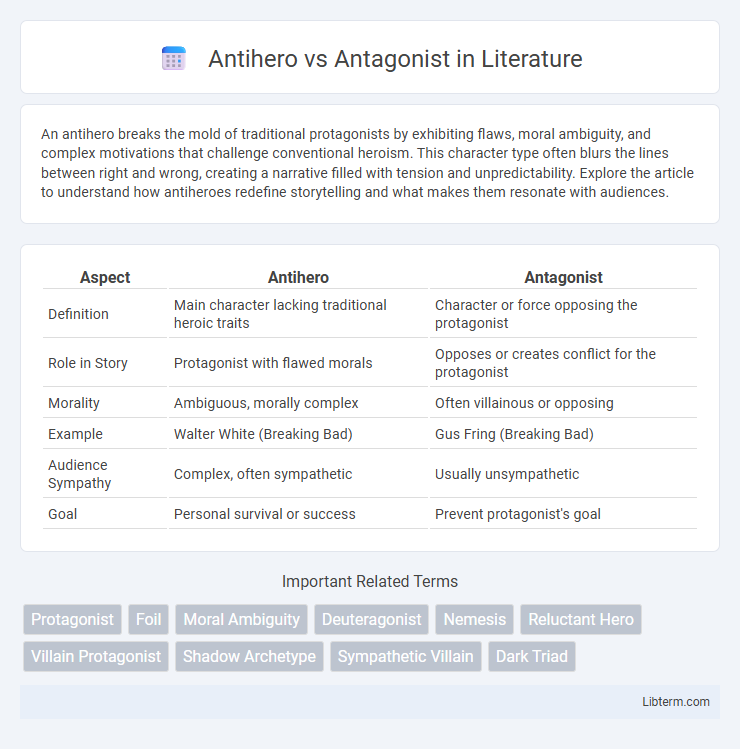An antihero breaks the mold of traditional protagonists by exhibiting flaws, moral ambiguity, and complex motivations that challenge conventional heroism. This character type often blurs the lines between right and wrong, creating a narrative filled with tension and unpredictability. Explore the article to understand how antiheroes redefine storytelling and what makes them resonate with audiences.
Table of Comparison
| Aspect | Antihero | Antagonist |
|---|---|---|
| Definition | Main character lacking traditional heroic traits | Character or force opposing the protagonist |
| Role in Story | Protagonist with flawed morals | Opposes or creates conflict for the protagonist |
| Morality | Ambiguous, morally complex | Often villainous or opposing |
| Example | Walter White (Breaking Bad) | Gus Fring (Breaking Bad) |
| Audience Sympathy | Complex, often sympathetic | Usually unsympathetic |
| Goal | Personal survival or success | Prevent protagonist's goal |
Defining the Antihero
An antihero is a central character in a story who lacks conventional heroic qualities such as idealism, courage, or morality, often displaying flawed, ambiguous, or morally complex traits that challenge traditional definitions of a hero. Unlike an antagonist, who opposes the protagonist and drives conflict, the antihero serves as the main character whose actions may be questionable but are essential to the narrative's progress. Notable examples include Walter White from "Breaking Bad" and Tony Soprano from "The Sopranos," characters who embody the antihero archetype by blending heroic and villainous elements.
Understanding the Antagonist
The antagonist in a story is the character who opposes the protagonist, creating conflict and driving the plot forward. Unlike an antihero, who may lack conventional heroic qualities but remains the story's central character, the antagonist's role is to challenge or obstruct the hero's goals. Understanding the antagonist involves analyzing their motivations, desires, and the thematic purpose they serve within the narrative structure.
Core Differences Between Antihero and Antagonist
An antihero embodies complex traits and moral ambiguity, often serving as the story's central character with flawed but relatable qualities. In contrast, an antagonist primarily functions as the opposition to the protagonist, driving conflict without necessarily possessing nuanced character depth. The core difference lies in the antihero's role as a protagonist with unconventional ethics, whereas the antagonist is defined by their adversarial position within the narrative.
The Role of Antiheroes in Storytelling
Antiheroes serve as complex protagonists who challenge traditional hero archetypes by embodying morally ambiguous traits, offering a nuanced perspective in storytelling. Their internal conflicts and flawed nature create relatable characters that engage audiences on a deeper emotional level. Unlike antagonists, who oppose the hero's goals, antiheroes drive the narrative through their personal struggles and unconventional methods.
Motivation and Morality: Antihero vs Antagonist
Antiheroes exhibit complex motivations often driven by personal codes or flawed ethics, blurring the lines between right and wrong. Antagonists typically embody opposition to the protagonist's goals, motivated by conflicting desires or ideologies that challenge the hero's journey. While antiheroes wrestle with internal moral ambiguity, antagonists are defined by their external conflict and resistance to the protagonist's values.
Common Traits of Antiheroes
Antiheroes share several common traits such as moral ambiguity, complex motivations, and flawed characteristics that make them relatable and multidimensional. Unlike traditional heroes, antiheroes often exhibit selfishness, questionable ethics, and a willingness to bend or break rules to achieve their goals. Their actions and decisions blur the line between good and evil, challenging conventional notions of heroism and creating a compelling narrative tension within the story.
Typical Characteristics of Antagonists
Antagonists typically exhibit traits such as opposition to the protagonist's goals, creating conflict that drives the narrative forward. They often possess distinct motivations, whether personal, ideological, or circumstantial, that challenge the protagonist's beliefs or values. Unlike antiheroes, antagonists are generally characterized by their role as obstacles or sources of tension rather than morally ambiguous protagonists.
Antihero Archetypes in Popular Culture
Antihero archetypes in popular culture often blur traditional moral lines, featuring protagonists like Walter White from "Breaking Bad," who embody complex motivations and flawed characteristics. Unlike antagonists who oppose the hero's goals, antiheroes drive narratives through their internal struggles and ambiguous ethics. This nuanced portrayal challenges audience perceptions, making antiheroes compelling figures in modern storytelling.
Antagonist Examples in Literature and Film
Antagonists serve as the primary opposition to protagonists, driving conflict in literature and film. Classic examples include Iago from Shakespeare's "Othello," whose manipulative schemes fuel the tragedy, and Darth Vader from "Star Wars," embodying the dark force opposing the heroes. These characters are defined by their opposition to the protagonist's goals, often embodying moral or ideological contrasts that heighten the narrative tension.
Impact of Antiheroes and Antagonists on Audience Engagement
Antiheroes captivate audiences by presenting complex, morally ambiguous characters that challenge traditional hero archetypes, thereby fostering deep emotional investment and introspection. Antagonists drive conflict and tension, essential for plot progression, but may evoke fear or dislike rather than empathy, creating a different type of audience engagement rooted in opposition. The interplay between antiheroes and antagonists often heightens narrative depth, stimulating audience curiosity and sustained attention throughout the story.
Antihero Infographic

 libterm.com
libterm.com